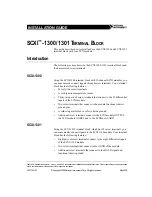
Chapter 9
Configuring Online Communication
9–12
Recommendations When Using DH-485 Devices
The following summarizes the recommendations for a DH–485 network.
•
Use node 0 (default) and the lowest node numbers for the programming
device(s).
•
Number the processor nodes consecutively, beginning at the lowest
possible number.
•
When establishing a multi–node network, keep in mind that the default
node address for a processor is 1. This means that unless the address has
been changed previously, all processor nodes on the network initially
have node address 1, this makes it impossible to communicate with an
individual processor. You must bring up the network one node at a time,
assigning each node address before proceeding to the next.
•
Set the maximum node address as low as possible. The highest numbered
node should have its maximum node address set to its own address.
•
Set the maximum node address the same for all nodes on the network.
•
Make certain that the baud rate settings of all nodes are the same. A
terminal only communicates with processors set at the same baud rate.
The baud rate change for a processor does not take effect until you cycle
power to the processor. The default baud rate for a device on the network
is 19200.
•
Make certain that the node address and baud rate are correct before
making a processor memory change using the upload or download
functions. These functions overwrite the existing node address and
existing baud rate when you cycle processor power.
!
ATTENTION: If two processors on the DH–485 network are
assigned the same node address, it is possible that the processor
file in one of the processors will be lost and replaced with the
default file.















































